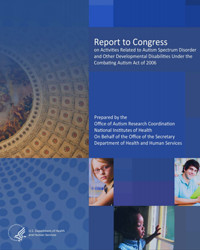Report to Congress
on Activities Related to Autism Spectrum Disorder and Other Developmental Disabilities
FY 2006 - FY 2009
In the past four years under the provisions of the Combating Autism Act of 2006 (CAA) (P.L. 109-416), significant advances have been made in our understanding of ASD. Notably, reliable estimates of the prevalence of ASD and a clearer picture of both the opportunities and gaps that exist in ASD research and services are now available. With substantial Federal support, researchers continue the crucial task of evaluating interventions that provide lasting, meaningful benefit to people with ASD. Large-scale efforts in data collection, consolidation, and sharing are empowering researchers and health practitioners with knowledge not available only a few years ago. With increasing phenotypic and biological knowledge, medical practitioners are beginning to classify sub-categories of the wide spectrum of autistic disorders, which will be crucial in future efforts to provide individually-tailored interventions. Within the biomedical research community, there is optimism that a continued rigorous focus on identifying genetic and environmental triggers to ASD will yield innovative treatment and prevention strategies.
Through intensive surveillance and research efforts, researchers and Federal agencies can also better identify the unmet societal needs surrounding ASD. While the median age for ASD diagnosis (~4.5 years of age) appears to be on the decline, CDC data indicate a critical need for improved access to early evaluation and diagnostic services. The typical time gap from developmental concern to diagnosis is over 2 years. With a continued focus on ASD awareness and training, within both the public and healthcare spheres, this critical time gap can be lessened. Increased attention is being given to pinpointing underserved communities where diagnostic and intervention support is in the greatest need. Strategic efforts aimed at underserved populations are under way to encourage ASD awareness, early diagnosis, and intervention, but additional efforts will be needed to provide the necessary evidence base to support a wide variety of new interventions and services and supports to provide for the needs of people on the autism spectrum. In addition, services and supports programs across several Federal agencies are actively identifying best practices and implementing programs to increase quality of life for people with ASD across the lifespan.
Finally, the Federal coordination provided by the Interagency Autism Coordinating Committee (IACC) has successfully identified key research and services priorities and has fostered enhanced communication and collaboration between Federal agencies, private foundation partners and the public. This Federal coordination will continue to be needed to monitor progress, provide a forum for public input into Federal ASD policy, and help agencies bring critical research into practice in the form of effective programs to help people with ASD and their families.




